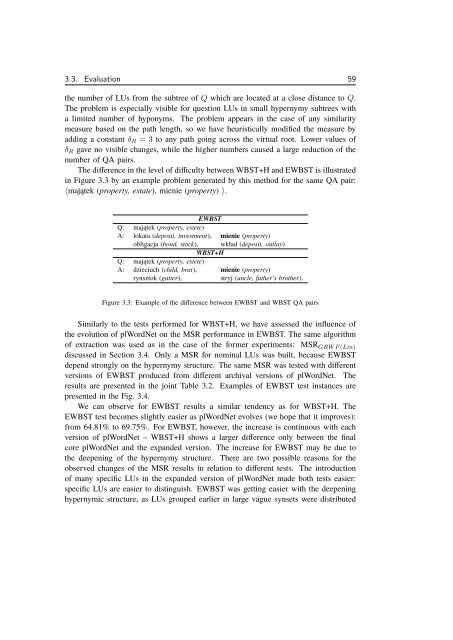A Wordnet from the Ground Up
A Wordnet from the Ground Up - School of Information Technology ...
A Wordnet from the Ground Up - School of Information Technology ...
Create successful ePaper yourself
Turn your PDF publications into a flip-book with our unique Google optimized e-Paper software.
3.3. Evaluation 59<strong>the</strong> number of LUs <strong>from</strong> <strong>the</strong> subtree of Q which are located at a close distance to Q.The problem is especially visible for question LUs in small hypernymy subtrees witha limited number of hyponyms. The problem appears in <strong>the</strong> case of any similaritymeasure based on <strong>the</strong> path length, so we have heuristically modified <strong>the</strong> measure byadding a constant δ R = 3 to any path going across <strong>the</strong> virtual root. Lower values ofδ R gave no visible changes, while <strong>the</strong> higher numbers caused a large reduction of <strong>the</strong>number of QA pairs.The difference in <strong>the</strong> level of difficulty between WBST+H and EWBST is illustratedin Figure 3.3 by an example problem generated by this method for <strong>the</strong> same QA pair:〈majątek (property, estate), mienie (property) 〉.EWBSTQ: majątek (property, estete)A: lokata (deposit, investment), mienie (property)obligacja (bond, stock), wkład (deposit, outlay)WBST+HQ: majątek (property, estete)A: dzieciuch (child, brat), mienie (property)rynsztok (gutter),stryj (uncle, fa<strong>the</strong>r’s bro<strong>the</strong>r).Figure 3.3: Example of <strong>the</strong> difference between EWBST and WBST QA pairsSimilarly to <strong>the</strong> tests performed for WBST+H, we have assessed <strong>the</strong> influence of<strong>the</strong> evolution of plWordNet on <strong>the</strong> MSR performance in EWBST. The same algorithmof extraction was used as in <strong>the</strong> case of <strong>the</strong> former experiments: MSR GRW F (Lin)discussed in Section 3.4. Only a MSR for nominal LUs was built, because EWBSTdepend strongly on <strong>the</strong> hypernymy structure. The same MSR was tested with differentversions of EWBST produced <strong>from</strong> different archival versions of plWordNet. Theresults are presented in <strong>the</strong> joint Table 3.2. Examples of EWBST test instances arepresented in <strong>the</strong> Fig. 3.4.We can observe for EWBST results a similar tendency as for WBST+H. TheEWBST test becomes slightly easier as plWordNet evolves (we hope that it improves):<strong>from</strong> 64.81% to 69.75%. For EWBST, however, <strong>the</strong> increase is continuous with eachversion of plWordNet – WBST+H shows a larger difference only between <strong>the</strong> finalcore plWordNet and <strong>the</strong> expanded version. The increase for EWBST may be due to<strong>the</strong> deepening of <strong>the</strong> hypernymy structure. There are two possible reasons for <strong>the</strong>observed changes of <strong>the</strong> MSR results in relation to different tests. The introductionof many specific LUs in <strong>the</strong> expanded version of plWordNet made both tests easier:specific LUs are easier to distinguish. EWBST was getting easier with <strong>the</strong> deepeninghypernymic structure, as LUs grouped earlier in large vague synsets were distributed



